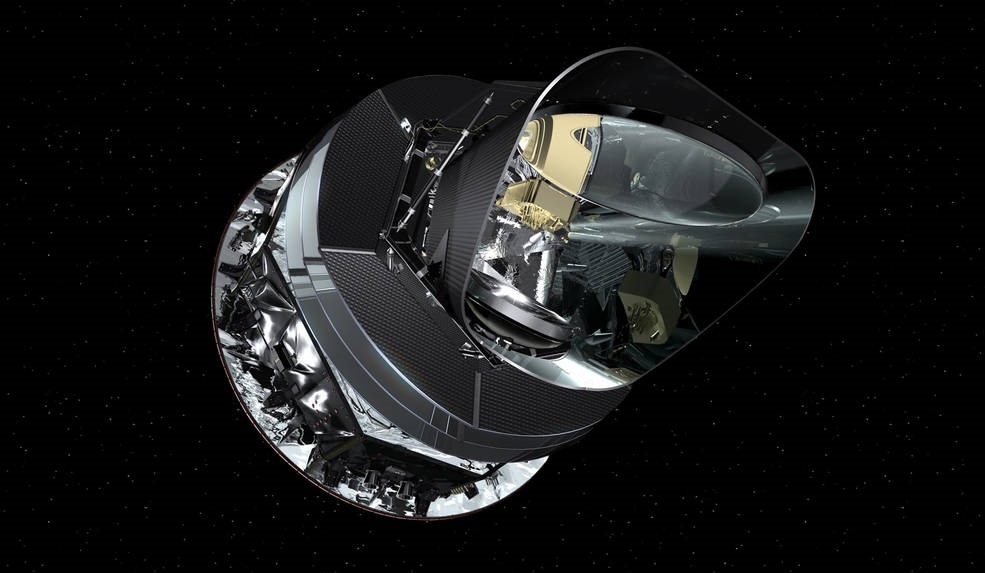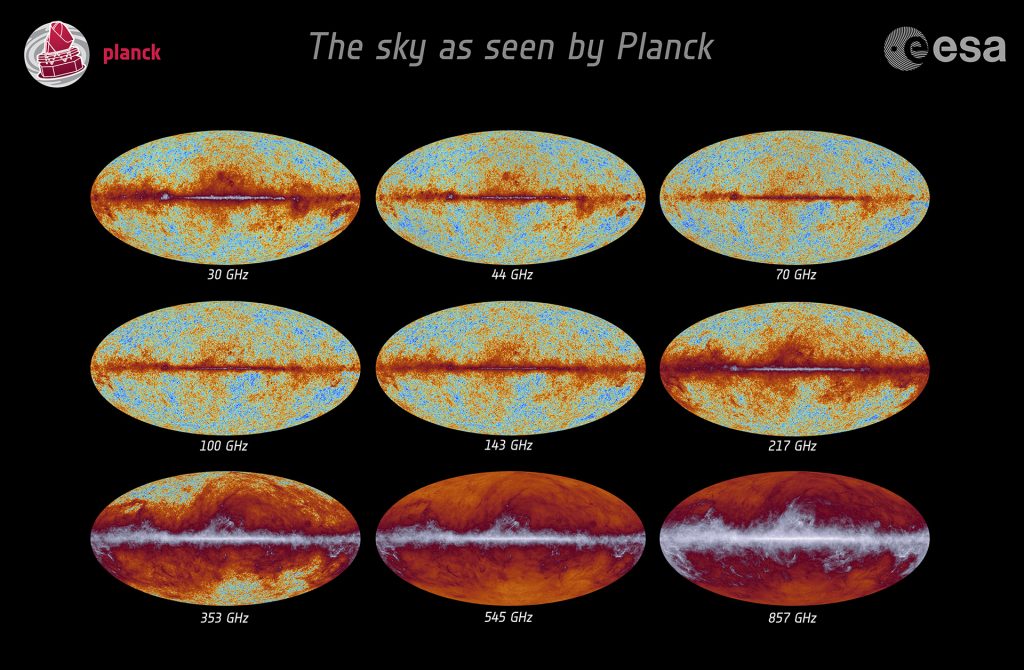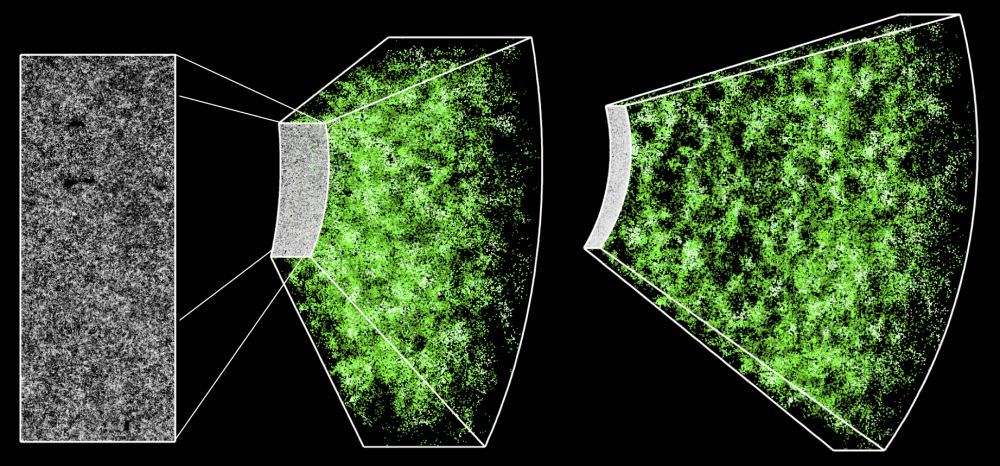For almost a century, astronomers have understood that the Universe is in a state of expansion. Since the 1990s, they have come to understand that as of four billion years ago, the rate of expansion has been speeding up. As this progresses, and the galaxy clusters and filaments of the Universe move farther apart, scientists theorize that the mean temperature of the Universe will gradually decline.
But according to new research led by the Center for Cosmology and AstroParticle Physics (CCAPP) at Ohio State University, it appears that the Universe is actually getting hotter as time goes on. After probing the thermal history of the Universe over the last 10 billion years, the team concluded that the mean temperature of cosmic gas has increased more than 10 times and reached about 2.2 million K (~2.2 °C; 4 million °F) today.
The study that describes their findings, “The Cosmic Thermal History Probed by Sunyaev–Zeldovich Effect Tomography“, recently appeared in The Astrophysical Journal. The study was led by Yi-Kuan Chiang, a research fellow at the CCAP, and included members from the Kavli Institute for the Physics and Mathematics of the Universe (Kavli IPMU), The Johns Hopkins University, and the Max-Planck-Institute for Astrophysics.

For the sake of their study, the the team examined thermal data on the Large-Scale Structure (LSS) of the universe. This refers to patterns of galaxies and matter on the largest of cosmic scales, which is the result of the gravitational collapse of dark matter and gas. As Dr. Chiang explained in an Ohio State News release:
“Our new measurement provides a direct confirmation of the seminal work by Jim Peebles — the 2019 Nobel Laureate in Physics — who laid out the theory of how the large-scale structure forms in the universe. As the universe evolves, gravity pulls dark matter and gas in space together into galaxies and clusters of galaxies. The drag is violent — so violent that more and more gas is shocked and heated up.”
To measure thermal changes over the past 10 billion years, Chiang and his colleagues combined data from by the ESA’s Planck Infrared Astronomical Satellite and the Sloan Digital Sky Survey (SDSS). Whereas Planck was the first European mission to measure the temperature of the Cosmic Microwave Background (CMB), SDSS is a a massive multi-spectral survey that has created the most detailed 3D maps of the Universe.
From these data sets, the team cross-correlated eight of Planck‘s sky intensity maps with two million spectroscopic redshift references from the SDSS. Combing redshift measurements (which are routinely used to determine how fast are objects are moving away from us) and temperature estimates based on light, the team compared the temperature of more distant gas clouds (farther back in time) with those closer to Earth.

From this, the research team was able to confirm that the mean temperature of gases in the early Universe (ca. 4 billion after the Big Bang) was lower than it is now. This is apparently due to the gravitational collapse of the cosmic structure over time, a trend which will continue and become more intense as the expansion of the Universe continues to accelerate.
As Chiang summarized, the Universe is warming because of the natural process of galaxy and structure formation, and is unrelated to temperature changes here on Earth:
“As the universe evolves, gravity pulls dark matter and gas in space together into galaxies and clusters of galaxies. The drag is violent — so violent that more and more gas is shocked and heated up… These phenomena are happening on very different scales. They are not at all connected.”
In the past, many astronomers have argued that the cosmos would continue to cool as it expanded, something that would inevitably result in the the “Big Chill” (or “Big Freeze”). In contrast, Chiang and his associates showed that scientists can clock the evolution of cosmic structure formation by “checking the temperature” of the Universe.

These findings could also have implications for theories that accept “cosmic cooling” as a foregone conclusion. On the one hand, it has been suggested that a possible resolution to the Fermi Paradox is that extraterrestrial intelligences (ETIs) are dormant and waiting for the Universe to improve (the Aestivation Hypothesis).
Based in part on the thermodynamics of computing (the Landauer’s Principle), the argument states that as the Universe cools, advanced species would be able to get far more out of their megastructures. Also, if the cosmos is going to get hotter over time, does that mean that the emergence of life will become less likely over time due to increased cosmic radiation?
Assuming there is no mechanism for maintaining a certain thermal equilibrium, would this mean that the Universe will not end in a “Big Chill,” but a “Big Blaze”? As Robert Frost famously wrote, “Some say the world will end in fire, others say in ice.” Which of these will prove to be correct, and what implications it could have for life in the future, only time will tell…
Further Reading: Ohio State News, The Astrophysical Journal


It seems to me the article confuses the heating of the cosmic web of filaments consisting of gas and galaxies with the entire universe where the voids continue to cool and expand?! The expansion is adiabatic free, so is cooling the universe as a system.
The injection of the SETI question leaves me cold as well. E.g. how could anyone build “megastructures” in the face of the universal speed limit?
Errata: “adiabatic free” = adiabatic cooling.
Maybe I’m thinking simplistically, because I’m not an astrophysicist, but assuming the Universe would be cooling at a more constant rate of expansion …. can a connection be made between the increasing temperature of the Universe and its increasing rate of expansion? Has our dark energy always been here, or is MORE dark energy coming from “somewhere else”?
We sometimes talk about the “multiverse.” Brian Greene once compared our own universe to single slice of bread in a much larger loaf of many universes. Suppose some unfathomably advanced intelligences in a different universe determined that it was in their best interests to slow the expansion of their own universe. Could they do that by sending some of their energy elsewhere … say, into OUR universe?
Just some speculation on my part.
It is interesting to try to unpack that.
First we have the context of multiverses, which our modern inflationary hot big bang [“Lambda Cold Dark Matter”] cosmology imply as its simplest state due to inflation being slow roll.
For some of the physics I recommend browsing PBS Space Time videos which are presented by astrophysicist Marr Dowd [“What Happened Before Big Bang” specifically in this case]. But if the cosmology seems unfamiliar, the video “The Big Bang is Probably Not What You Think”, scripted by astrophysicist Katie Mack, is a short intro (but with no mechanisms explained).
Given that each habitable universe is causally disconnected by the inflationary expansion we cannot causally observe or else affect them or vice versa. [One can also discuss what we mean by “sending energy”, but given that they would have a Lambda – vacuum energy (“dark energy”) density – close to but different than ours there could be thermodynamic work if a causal bridge could be opened.]
Second, in that context our local universe vacuum energy emerged after inflation stopped locally, before that the frustrated vacuum of inflation was at the much higher potential energy of the practically universal inflation field (or some 10^3 – 10^5 from Planck energy density). See Dowd’s video [and another reference is the Planck collaboration 2018 final cosmology summary paper where they managed to observe the slow roll inflation potential, see Planck Legacy Archive]. *Our* dark energy of our universe has been there as long as our universe has, and it is likely the sum of the many different quantum field’s (see the Standard Model of forces and particles for many of the fields) vacuum energies.
Third and last, what is ” the increasing temperature of the Universe” – why does it increase? During inflation its quantum field had fluctuations, which energy density variation left an imprint in the hot big bang radiation during the release of potetntial energy as the field locally stopped rolling and the new vacuum was established.
The imprint of variation in energy was converted in an imprint of variation in momentum and density of the particles in radiation and matter, and later became an imprint that we call the cosmic background radiation spectra. That imprint was the seed for structure formation as the variations overlapped in caustics (like the ones of light you can see a cross section of at the bottom of a swimming pool as sunlight is randomly diffracted at the rippling water surface).
In other words, since now radiation had been so diluted it no longer dominated, the gas built what we observe as the cosmic web of filaments. As gravity contracts the filaments, mainly dark matter, galaxies could form and they and the gas stream towards the nodes of the web as well as the filaments themselves thin out from it. That infalling matter creates the shock waves that, together with the compactification, produce heat – the heat that the new science paper reports have been observed.
That is why I want to keep the heating of the filaments and the cooling of the universe – which must and does cool with the adiabatic expansion as we can see in the cosmic background – apart.
The background photons outnumber the matter by a factor 10^9 as current matter is a residual when matter and antimatter almost entirely annihilated. And the photon wavelength have been stretched by a factor 1000 – from a black body photon spectra peaking at 3,000 K to a peak at 3 K – so they have lost thermal energy and proportionally much more than the filaments have been heated at a factor roughly 10.
I hope that describes the connection between heating and cooling [I’m not an expert].
I forgot – there is also the technical point that the virial theorem, which keeps tabs on the sum of kinetic and potential energy in a gravitationally bound system, implies that a gravitationally contracting system can only do so by radiating heat to the colder universe. So you simply can’t heat the entire universe that way, at least as long as it expands and there are local bound systems to speak of. (Contracting universes has a physics that I luckily don’t need to worry about.)